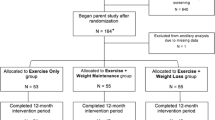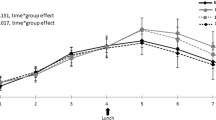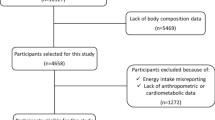Abstract
Background/Objectives:
Most of the interventional studies have investigated the impact of the diet on adiponectin and leptin concentrations only in men or in women. Consequently, it is still unknown whether the consumption of a healthy diet influences in a sex-specific manner these adipocytokines. We examined sex differences in the effects of the Mediterranean diet (MedDiet) on adiponectin and leptin concentrations, and determined whether changes in these adipocytokines are associated with changes in cardiovascular risk factors in both sexes.
Subjects/Methods:
Participants were 38 men and 32 premenopausal women (24–53 years) with slightly elevated low-density lipoprotein cholestrol concentrations (3.4–4.9 mmol/l) or total cholesterol/high-density lipoprotein cholestrol (HDL-C)⩾5.0. Adiponectin, leptin and cardiovascular risk factors were measured before and after a 4-week fully controlled isoenergetic MedDiet.
Results:
Adiponectin concentration decreased in response to the MedDiet, but this decrease reached statistical significance only in men (P<0.001 for men and P=0.260 for women; sex-by-time interaction, P=0.072). Adjustments for body weight or waist circumference did not change results obtained. Changes in adiponectin were positively associated with concomitant variations in HDL-C in men (r=0.52, P=0.003) and with variations in apolipoprotein A-1 and insulin sensitivity as calculated by both the homeostasis model assessment index for insulin sensitivity and Cederholm indices in women (respectively, r=0.44, P=0.021; r=0.79, P<0.001 and r=0.47, P=0.020). The MedDiet had no impact on leptin and the leptin-to-adiponectin ratio in both sexes.
Conclusions:
Results suggest a sex difference in adiponectin response to the short-term consumption of the MedDiet, with only men experiencing a decrease. Also sex-specific patterns of associations between changes in adiponectin concentration and changes in cardiovascular risk factors were observed.
This is a preview of subscription content, access via your institution
Access options
Subscribe to this journal
Receive 12 print issues and online access
$259.00 per year
only $21.58 per issue
Buy this article
- Purchase on Springer Link
- Instant access to full article PDF
Prices may be subject to local taxes which are calculated during checkout
Similar content being viewed by others
References
Turer AT, Scherer PE . Adiponectin: mechanistic insights and clinical implications. Diabetologia 2012; 55: 2319–2326.
Brooks NL, Moore KS, Clark RD, Perfetti MT, Trent CM, Combs TP . Do low levels of circulating adiponectin represent a biomarker or just another risk factor for the metabolic syndrome? Diabetes Obes Metab 2007; 9: 246–258.
Zhang H, Mo X, Hao Y, Huang J, Lu X, Cao J et al Adiponectin levels and risk of coronary heart disease: a meta-analysis of prospective studies. Am J Med Sci 2013; 345: 455–461.
Spranger J, Kroke A, Mohlig M, Bergmann MM, Ristow M, Boeing H et al Adiponectin and protection against type 2 diabetes mellitus. Lancet 2003; 361: 226–228.
Söderberg S, Zimmet P, Tuomilehto J, Chitson P, Gareeboo H, Alberti KG et al Leptin predicts the development of diabetes in Mauritian men, but not women: a population-based study. Int J Obes 2007; 31: 1126–1133.
McNeely MJ, Boyko EJ, Weigle DS, Shofer JB, Chessler SD, Leonnetti DL et al Association between baseline plasma leptin levels and subsequent development of diabetes in Japanese Americans. Diabetes Care 1999; 22: 65–70.
Bandaru P, Shankar A . Association between plasma leptin levels and diabetes mellitus. Metab Syndr Relat Disord 2011; 9: 19–23.
Sattar N, Wannamethee G, Sarwar N, Chernova J, Lawlor DA, Kelly A et al Leptin and coronary heart disease prospective study and systematic review. J Am Coll Cardiol 2009; 53: 167–175.
Zhuo Q, Wang Z, Fu P, Piao J, Tian Y, Xu J et al Comparison of adiponectin, leptin and, leptin to adiponectin ratio as diagnostic marker for metabolic syndrome in older adults of Chinese major cities. Diabetes Res Clin Pract 2009; 84: 27–33.
Finucane FM, Luan J, Wareham NJ, Sharp SJ, O'Rahilly S, Balkau B et al Correlation of the leptin:adiponectin ratio with measures of insulin resistance in non-diabetic individuals. Diabetologia 2009; 52: 2345–2349.
Andreasson AN, Undén AL, Elofsson S, Brismar K . Leptin and adiponectin: distribution and associations with cardiovascular risk factors in men and women of the general population. Am J Hum Biol 2012; 24: 595–601.
Snijder MB, Heine RJ, Seidell JC, Bouter LM, Stehouwer CD, Nijpels G et al Associations of adiponectin levels with incident impaired glucose metabolism and type 2 diabetes in older men and women - the Hoorn study. Diabetes Care 2006; 29: 2498–2503.
Samara A, Herbeth B, Aubert R, Berrahmoune H, Fumeron F, Siest G et al Sex-dependent associations of leptin with metabolic syndrome-related variables: the Stanislas Study. Obesity 2010; 18: 196–201.
Bédard A, Riverin M, Dodin S, Corneau L, Lemieux S . Sex differences in the impact of the Mediterranean diet on cardiovascular risk profile. Br J Nutr 2012; 108: 1428–1434.
Minister of Health Canada Eating Well with Canada's Food Guide. 2007 http://www.hc-sc.gc.ca/fn-an/alt_formats/hpfb-dgpsa/pdf/food-guide-aliment/view_eatwell_vue_bienmang-eng.pdf. Accessed 19 January 2014.
Goulet J, Nadeau G, Lapointe A, Lamarche B, Lemieux S . Validity and reproducibility of an interviewer-administered food frequency questionnairefor healthy French-Canadian men and women. Nutr J 2004; 3: 13.
Hardie L, Trayhurn P, Abramovich D, Fowler P . Circulating leptin in women: a longitudinal study in the menstrual cycleand during pregnancy. Clin Endocrinol 1997; 47: 101–106.
Escalante Pulido JM, Alpizar Salazar M . Changes in insulin sensitivity, secretion and glucose effectiveness during menstrual cycle. Arch Med Res 1999; 30: 19–22.
Muesing RA, Forman MR, Graubard BI, Beecher GR, Lanza E, McAdam PA et al Cyclic changes in lipoprotein and apolipoprotein levels during the menstrual cyclein healthy premenopausal women on a controlled diet. J Clin Endocrinol Metab 1996; 81: 3599–3603.
Friedewald WT, Levy RI, Fredrickson DS . Estimation of the concentration of low-density lipoprotein cholesterol in plasma, without use of the preparative ultracentrifuge. Clin Chem 1972; 18: 499–502.
Albers JJ, Warnick GR, Wiebe D, King P, Steiner P, Smith L et al Multi-laboratory comparison of three heparin-Mn2+ precipitation procedures for estimating cholesterol in high-density lipoprotein. Clin Chem 1978; 24: 853–856.
Richterich R, Dauwalder H . Determination of plasma glucose by hexokinase-glucose-6-phosphate dehydrogenase method. Schweiz Med Wochenschr 1971; 101: 615–618.
Desbuquois B, Aurbach GD . Use of polyethylene glycol to separate free and antibody-bound peptide hormones in radioimmunoassays. J Clin Endocrinol Metab 1971; 33: 732–738.
Rowland M Tozer TN . Clinical Pharmacokinetics: Concepts and Applications. Lea and Febiger: Philadelphia, PA, USA, 1980.
Cederholm J, Wibell L . Insulin release and peripheral sensitivity at the oral glucose tolerance test. Diabetes Res Clin Pract 1990; 10: 167–175.
The Airlie (VA) Consensus Conference: Standardization of Anthropometric easurements. Human Kinetics Publishers: Champaign, IL, USA, 1988.
Richard C, Couture P, Desroches S, Charest A, Lamarche B . Effect of the Mediterranean diet with and without weight loss on cardiovascular risk factors in men with the metabolic syndrome. Nutr Metab Cardiovasc Dis 2011; 21: 628–635.
Esposito K, Marfella R, Ciotola M, Di Palo C, Giugliano F, Giugliano G et al Effect of a mediterranean-style diet on endothelial dysfunction and markers of vascular inflammation in the metabolic syndrome: a randomized trial. JAMA 2004; 292: 1440–1446.
Fragopoulou E, Panagiotakos DB, Pitsavos C, Tampourlou M, Chrysohoou C, Nomikos T et al The association between adherence to the Mediterranean diet and adiponectin levels among healthy adults: the ATTICA study. J Nutr Biochem 2010; 21: 285–289.
Mantzoros CS, Williams CJ, Manson JE, Meigs JB, Hu FB . Adherence to the Mediterranean dietary pattern is positively associated with plasma adiponectin concentrations in diabetic women. Am J Clin Nutr 2006; 84: 328–335.
Esposito K, Pontillo A, Di Palo C, Giugliano G, Masella M, Marfella R et al Effect of weight loss and lifestyle changes on vascular inflammatory markers in obese women - a randomized trial. JAMA 2003; 289: 1799–1804.
Esposito K, Di Palo C, Maiorino MI, Petrizzo M, Bellastella G, Siniscalchi I et al Long-term effect of Mediterranean-style diet and calorie restriction on biomarkers of longevity and oxidative stress in overweight men. Cardiol Res Pract 2010; 2011: 293916.
Forsythe LK, Wallace JM, Livingstone MB . Obesity and inflammation: the effects of weight loss. Nutr Res Rev 2008; 21: 117–133.
Matsuzawa Y . Adiponectin: a key player in obesity related disorders. Curr Pharm Des 2010; 16: 1896–1901.
Schneider JG, von Eynatten M, Schiekofer S, Nawroth PP, Dugi KA . Low plasma adiponectin levels are associated with increased hepatic lipase activity in vivo. Diabetes Care 2005; 28: 2181–2186.
Benoit SC, Clegg DJ, Seeley RJ, Woods SC . Insulin and leptin as adiposity signals. Recent Progr Horm Res 2004; 59: 267–285.
Acknowledgements
We would like to thank Mélissa Pelletier for her precious contribution in the laboratory and Anne-Marie Hudon for her help in the acquisition of data. This research was supported by the Canadian Institutes of Health Research (MOP 84568) and the Heart and Stroke Foundation of Quebec (2007–180). Analyses included in the present manuscript were also supported by the Institute of Nutrition and Functional Foods (INAF). AB is a recipient of a studendship from the Canadian Institutes of Health Research (CIHR). This clinical trial was registered at www.clinicaltrials.gov as NCT01293344.
Author information
Authors and Affiliations
Corresponding author
Ethics declarations
Competing interests
The authors declare no conflict of interest.
Rights and permissions
About this article
Cite this article
Bédard, A., Tchernof, A., Lamarche, B. et al. Effects of the traditional Mediterranean diet on adiponectin and leptin concentrations in men and premenopausal women: do sex differences exist?. Eur J Clin Nutr 68, 561–566 (2014). https://doi.org/10.1038/ejcn.2014.27
Received:
Revised:
Accepted:
Published:
Issue Date:
DOI: https://doi.org/10.1038/ejcn.2014.27
This article is cited by
-
Sexual dimorphism in cardiometabolic health: the role of adipose tissue, muscle and liver
Nature Reviews Endocrinology (2021)
-
Dietary fat and carbohydrate modulate the effect of the ATP-binding cassette A1 (ABCA1) R230C variant on metabolic risk parameters in premenopausal women from the Genetics of Atherosclerotic Disease (GEA) Study
Nutrition & Metabolism (2015)



